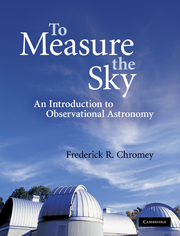5 - Optics for astronomy
Published online by Cambridge University Press: 05 June 2012
Summary
But concerning vision alone is a separate science formed among philosophers, namely, optics …. It is possible that some other science may be more useful, but no other science has so much sweetness and beauty of utility. Therefore it is the flower of the whole of philosophy and through it, and not without it, can the other sciences be known.
– Roger Bacon, Opus Maius, Part V, 1266–1268Certainly Bacon's judgment that optics is the gateway to other sciences is particularly true of astronomy, since virtually all astronomical information arrives in the form of light. We devote the next two chapters to how astronomers utilize the sweetness and beauty of optical science. This chapter introduces the fundamentals.
We first examine the simple laws of reflection and refraction as basic consequences of Fermat's principle, then review the behavior of optical materials and the operation of fundamental optical elements: films, mirrors, lenses, fibers, and prisms.
Telescopes, of course, are a central concern, and we introduce the simple concept of a telescope as camera. We will see that the clarity of the image produced by a telescopic camera depends on many things: the diameter of the light-gathering element, the turbulence and refraction of the air, and, if the telescope uses lenses, the phenomenon of chromatic aberration. Concern with image quality, finally, will lead us to an extended discussion of monochromatic aberrations and the difference between the first-order and higher-order ray theories of light.
- Type
- Chapter
- Information
- To Measure the SkyAn Introduction to Observational Astronomy, pp. 118 - 156Publisher: Cambridge University PressPrint publication year: 2010

